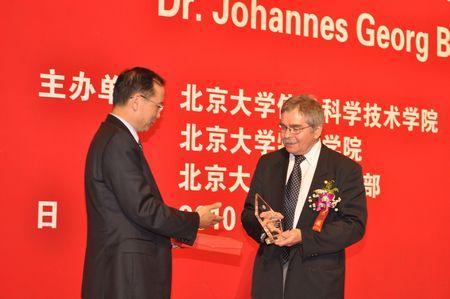Peking University, Nov. 25, 2010: Invited by School of Electronics Engineering and Computer Science (EECS), Dr. J. Georg Bednorz, winner of Nobel Prize in Physics in 1987 and researcher of IBM Zurich Research Laboratory, visited Peking University (PKU) from November 15 to 20. On the afternoon of November 17, Dr. Bednorz delivered an excellent lecture entitled "Physics in nano-scale system: nanoscience towards a new technology" at Sunshine Hall, Yingjie Overseas Exchange Center.

PKU executive vice president Lin Jianhua gave the memorial plaque to Dr. J. Georg Bednorz.
Prof. Lin Jianhua, executive vice president of PKU, had a cordial conversation with Dr. Bednorz in the VIP room before the lecture and gave the memorial plaque of "PKU Lecture Room on Information Technology and Informatization". Prof. Lin gave a welcoming speech at the beginning of the lecture. Prof. Zhu Xing, assistant president of PKU, together with other professors, attended this speech, which was chaired by Prof. Huang Ru, vice dean of EECS.
In his speech, Dr. Bednorz briefly recalled the development process of nanotechnology, from its original form to the modern disciplines with accurate measurement and control as their characteristics. Then, he stressed on the typical examples of scanning tunneling microscope (STM) used in the research of atomic and nano-scale manipulation, imaging, and physical phenomena (e.g. confinement effect) to show its importance. Besides, Dr. Bednorz illustrated STM's applications in the electronics, photonics, and mechanics. After the speech, Dr. Bednorz answered questions from the audience with great interest.
More than 400 teachers and students from EECS, School of Physics, College of Chemistry and Molecular Engineering, National Center for Nanoscience and Technology as well as Institute of Physics, CAS were attracted by this lecture.
During this period, Dr. Bednorz had discussions with students on several specific issues and gave some constructive suggestions while visiting the Institute of Quantum Electronics, Institute of Physical Electronics, and some laboratories of School of Physics.
Background
Dr. J. Georg Bednorz, along with his colleague, K. Alexander Mueller, was awarded the Nobel Prize in Physics in 1987 for his discovery of high-temperature superconductivity in a new class of materials. Dr. Bednorz and Mueller startled the world by reporting superconductivity in a layered, ceramic material at a then-record-high temperature -- 33 degrees above absolute zero, or 0 Kelvin (roughly -460 degrees Fahrenheit). Their discovery set off an avalanche of research worldwide into related materials that yielded dozens of new superconductors, eventually reaching a transition temperature of 135 Kelvin.
Born May 16, 1950 in Neuenkirchen, West Germany, Dr. Bednorz was educated at the University of Munster, where he received his master's degree in 1976, and the Swiss Federal Institute of Technology in Zurich, where he received his doctorate degree in 1982. While an undergraduate, Dr. Bednorz spent three months at the IBM Zurich Research Laboratory as a summer intern. After finishing his studies, he joined the Zurich laboratory as a researcher in 1982.
Today, his activities as an IBM Fellow concentrate on the development of complex oxide compounds with novel crystal structures and their specific modification for possible implementation in microelectronics.
Translated by: Wang Shiqin
Edited by: Su Juan
Source: PKU News (Chinese)





